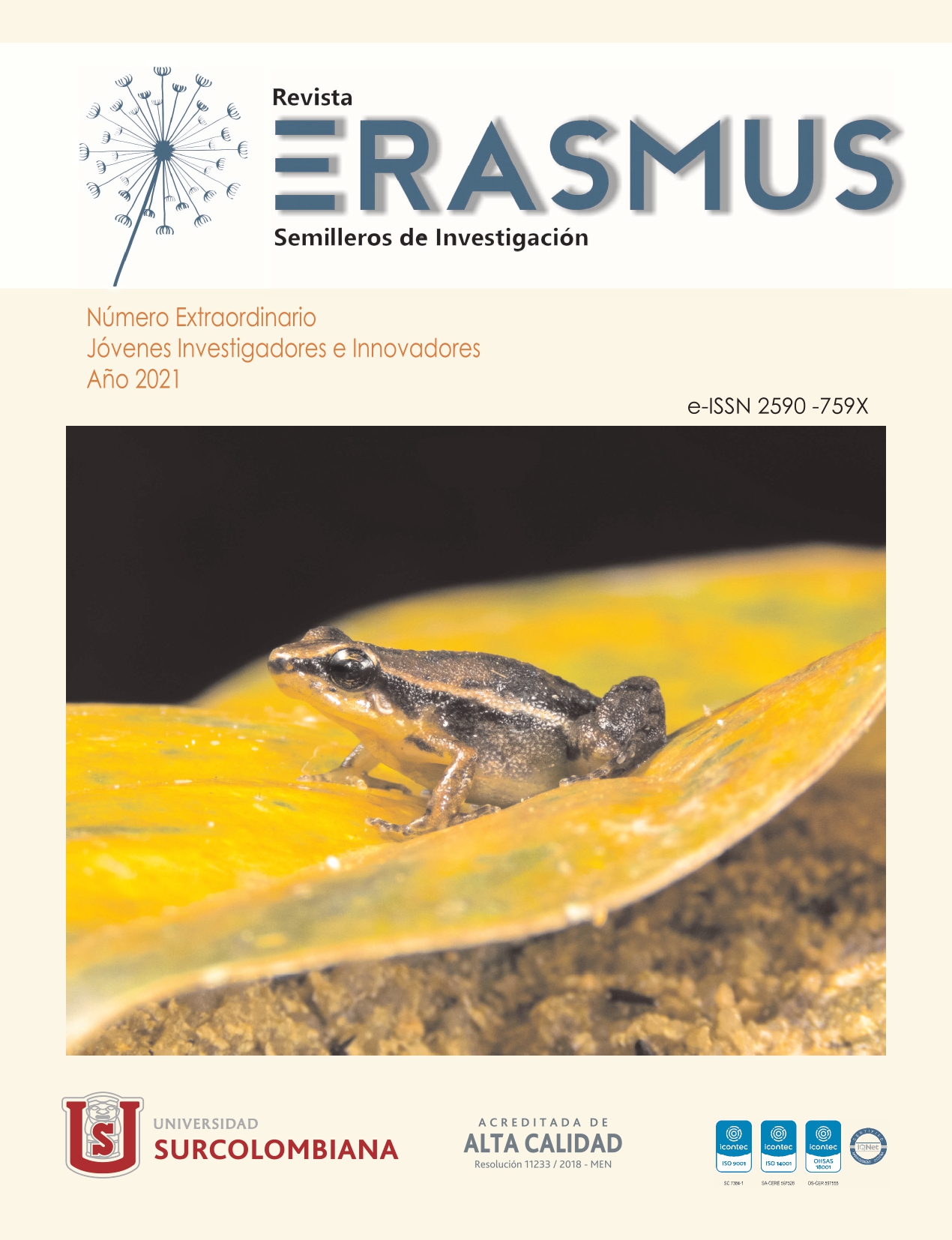Llamado a realizar un adecuado uso de los subproductos del café
##plugins.themes.bootstrap3.article.main##
En la actualidad la cantidad de residuos generados por la industria del café es aproximadamente de 784.000 ton/año de biomasa residual, que incluyen el mucilago, pulpa, cascarilla, café molido mojado (Borra), entre otros (Serna-Jiménez, 2018); Este artículo presenta una propuesta de solución a los actuales problemas de eliminación de subproductos en la industria cafetera, tomando como base el proyecto: Desarrollo de un nuevo producto de infusión a base de pulpa de café deshidratada (sultana), cofinanciado por Colciencias y la universidad Surcolombiana, en el cual se evaluó el comportamiento químico de la pulpa de café deshidratada, así como la caracterización física y sensorial de la infusión. Realizado con el propósito de transmitir los resultados a los pequeños productores del sector cafetero, incentivándolos a implementar el uso de los subproductos, generando el valor añadido al café con bajos costos de inversión.
Descargas
##plugins.themes.bootstrap3.article.details##
Pacheco, Teresa M., y Torrez A´ lvarez, Sergio, y Almanza, Giovanna R. (2018). Cuantificaci´on de compuestos bioactivos en c´ascara de coffea arabica en bolivia. revista boliviana de qu´ımica, 35 (5), 123-132. issn: 0250-5460. disponible en: https://www.redalyc.org/articulo.oa?id=426358213001
Barrios Rodriguez, Y. F., Salas Calderon, K. T., Gir´on Hern´andez, J. (2020). Comparison of sensory attributes and chemical markers of the infrared spectrum between defective and non-defective Colombian coffee samples. Coffee Science, 15, 1–10. https://doi.org/10.25186/.v15i.1659
Murthy, P. S., Madhava Naidu, M. (2012). Sustainable management of coffee industry by-products and value addition—A review. Resources, Conservation and Recycling, 66, 45–58. https://doi.org/10.1016/j.resconrec.2012.06.005
Cheng, B., Furtado, A., Smyth, H. E., Henry, R. J. (2016). Influence of genotype and environment on coffee quality. Trends in Food Science Technology, 57, 20–30. https://doi.org/10.1016/j.tifs.2016.09.003
Clifford, M. N., Knight, S., Surucu, B., Kuhnert, N. (2006). Characterization by LC-MSnof Four New Classes of Chlorogenic Acids in Green Coffee Beans: Dimethoxycinnamoylquinic Acids, Diferuloylquinic Acids, Caffeoyl-dimethoxycinnamoylquinic Acids, and Feruloyl-dimethoxycinnamoylquinic Acids. Journal of Agricultural and Food Chemistry, 54(6), 1957–1969. https://doi.org/10.1021/jf0601665
Clifford, M., Ramirez-Martinez, J. (1991). Phenols and caffeine in wet-processed coffee beans and coffee pulp. Food Chemistry, 40(1), 35–42. https://doi.org/10.1016/0308-8146(91)90017-i
Craig, A. P., Franca, A. S., Oliveira, L. S. (2012a). Discrimination between defective and non-defective roasted coffees by diffuse reflectance infrared Fourier transform spectroscopy. LWT, 47(2), 505–511. https://doi.org/10.1016/j.lwt.2012.02.016
Craig, A. P., Franca, A. S., Oliveira, L. S. (2012b). Evaluation of the potential of FTIR and chemometrics for separation between defective and nondefective coffees. Food Chemistry, 132(3), 1368–1374. https://doi.org/10.1016/j.foodchem.2011.11.121
Craig, A. P., Franca, A. S., Oliveira, L. S., Irudayaraj, J., Ileleji, K. (2014). Application of elastic net and infrared spectroscopy in the discrimination between defective and non-defective roasted coffees. Talanta, 128, 393–400. https://doi.org/10.1016/j.talanta.2014.05.001
Esquivel, P., Jim´enez, V. M. (2012). Functional properties of coffee and coffee by-products. Food Research International, 46(2), 488–495. https://doi.org/10.1016/j.foodres.2011.05.028
Guzman, N. G., Baham´on Monje, A. F., Parrado Mu˜noz, L. X. (2018). ATR-FTIR FOR DISCRIMINATION OF ESPRESSO AND AMERICANO COFFEE PODS. Coffee Science, 13(4), 550. https://doi.org/10.25186/cs.v13i4.1499
Heeger, A., Kosi´nska-Cagnazzo, A., Cantergiani, E., Andlauer, W. (2017). Bioactives of coffee cherry pulp and its utilisation for production of Cascara beverage. Food Chemistry, 221, 969–975. https://doi.org/10.1016/j.foodchem.2016.11.067
ICONTEC., 2004. Norma T´ecnica Colombiana NTC 5247. Caf´e tostado en grano o molido. Determinaci´on de la acidez titulable.
Janissen, B., & Huynh, T. (2018). Chemical composition and value-adding applications of coffee industry by-products: A review. Resources, Conservation and Recycling, 128, 110–117. https://doi.org/10.1016/j.resconrec.2017.10.001
Lyman, D. J., Benck, R., Dell, S., Merle, S., & Murray-Wijelath, J. (2003). FTIR-ATR Analysis of Brewed Coffee: Effect of Roasting Conditions. Journal of Agricultural and Food Chemistry, 51(11), 3268–3272. https://doi.org/10.1021/jf0209793
Palominio García, L. R., Biasetto, C. R., Araujo, A. R., & Bianchi, V. L. D. (2015). Enhanced extraction of phenolic compounds from coffee industry’s residues through solid-state fermentation by Penicillium purpurogenum. Food Science and Technology, 35(4), 704–711. https://doi.org/10.1590/1678-457x.6834
Paradkar, M. M., & Irudayaraj, J. (2002). Rapid determination of caffeine content in soft drinks using FTIR–ATR spectroscopy. Food Chemistry, 78(2), 261–266. https://doi.org/10.1016/s0308-8146(02)00116-4
Pérez-Hernández, L. M., Chávez-Quiroz, K., Medina-Juárez, L. N., & Gámez Meza, N. (2013). COMPUESTOS FENÓLICOS, MELANOIDINAS Y ACTIVIDAD ANTIOXIDANTE DE CAFE VERDE Y PROCESADO DE LAS ESPECIES Coffea arabica Y Coffea canephora. BIOtecnia, 15(1), 51. https://doi.org/10.18633/bt.v15i1.136
Reis, N., Franca, A. S., & Oliveira, L. S. (2013). Quantitative evaluation of multiple adulterants in roasted coffee by Diffuse Reflectance Infrared Fourier Transform Spectroscopy (DRIFTS) and chemometrics. Talanta, 115, 563–568. https://doi.org/10.1016/j.talanta.2013.06.004
Ribeiro, J., Ferreira, M., & Salva, T. (2011). Chemometric models for the quantitative descriptive sensory analysis of Arabica coffee beverages using near infrared spectroscopy. Talanta, 83(5), 1352–1358. https://doi.org/10.1016/j.talanta.2010.11.001
Rodríguez-Durán, L. V., Ramírez-Coronel, M. A., Aranda-Delgado, E., Nampoothiri, K. M., Favela-Torres, E., Aguilar, C. N., & Saucedo-Castañeda, G. (2014). Soluble and Bound Hydroxycinnamates in Coffee Pulp (Coffea arabica) from Seven Cultivars at Three Ripening Stages. Journal of Agricultural and Food Chemistry, 62(31), 7869–7876. https://doi.org/10.1021/jf5014956
Serna-Jiménez, J. A., Torres-Valenzuela, L. S., Martínez Cortínez, K., & Hernández Sandoval, M. C. (2018). Aprovechamiento de la pulpa de café como alternativa de valorización de subproductos. Revista ION, 31(1), 37–42. https://doi.org/10.18273/revion.v31n1-2018006
Silverstein, R. M., Webster, F. X., & Kiemle, D. J. (2005). Spectrometric Identification of Organic Compounds (7.a ed.). John Wiley & Sons Inc.








